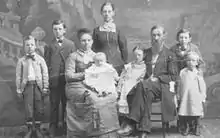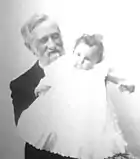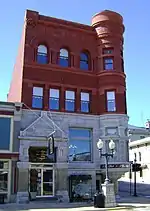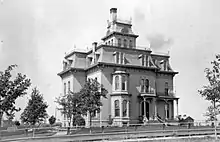Thomas Jefferson Ramsdell
Thomas Jefferson Ramsdell (1833–1917) was an entrepreneur from Manistee, Michigan. He served as the town's first and only attorney in the later part of the nineteenth century. He was a Michigan State Representative for a term. He served several terms of prosecuting attorney in Manistee County.
Thomas Jefferson Ramsdell | |
|---|---|
 1904 | |
| Born | July 19, 1832 Plymouth, Michigan |
| Died | 22 April 1917 (aged 84) Manistee, Michigan |
| Resting place | Oak Grove Cemetery in Manistee, Michigan |
| Occupation | lawyer |
| Nationality | American |
Ramsdell developed several of the town's commercial enterprises including a hardware store, the town's first downtown river bridge, the town's first newspaper, the town's first school house, the Ramsdell building, the Ramsdell Theatre, the First National Bank, the Manistee Water Works, and several Manistee downtown commercial blocks.
Early life
Ramsdell was born on a farm in Wayne County, Michigan, near the village of Plymouth on July 29, 1833. He is of Scottish descent. His parents came from Massachusetts after immigrating to the United States from Scotland twenty years earlier. Ramsdell had three other brothers; two farmers by the names of D. E. Ramsdell and W. A. Ramsdell, as well as a well known judge in Traverse City, Michigan. He divided his time between working on his father's farm in the summers and attending school in the winter as a boy.[1]
Ramsdell attended Plymouth Seminary in 1851, when he was nineteen years old. He taught school in between terms and graduated from the Seminary in 1856. His true interest was always in the legal profession. One year he was introduced to John W. Longyear and spent this time learning law from him. He then went on to the National Law School of Poughkeepsie in New York State and graduated from it in 1858. When he became legally a lawyer in Michigan's state capitol his first job in 1859 was as a clerk for the Michigan Supreme Court. It was here that he met Chief Justice George Martin of the supreme bench who suggested the lumbering town of Manistee as a place to start a law profession.[2]
Adult life





Manistee was in desperate need of a new lawyer about this time. With a legal library of books (suggested by Martin) Ramsdell set out with a horse and a small one seated sleigh in the winter of 1860 for Manistee. Manistee was then a very remote town and it took Ramsdell a week to make the journey to Manistee from Muskegon, Michigan. There were no roads going there north from Whitehall - only a blaze trail, which made it a tedious journey. At times his horse would give out and they would have to stop and rest. One time he traveled the complete night and progressed only five miles toward Manistee.[2]
Manistee was a wild, lawless frontier. History records that lumbermen wrote their own contracts, resulting in numerous legal problems from omitting items that should have been in the documents.[1] There were accounts of men walking all the way to Traverse City (over 50 miles) just to get a document that would get them out of the Manistee County jail.[3]
Ramsdell was welcomed by the entire whiskey-drinking community, which treated him with great respect. Because of the reverence they had for him, he was never asked to drink with them. He rode the law circuit with Judge Littlejohn and was known as the father of the circuit. Ramsdell pursued many projects in the 1860s in addition to his law practice in Manistee. In November 1860 he was elected to the Michigan State House of Representatives in which he served a single two-year term.[3][4] Ramsdell was also a member of the Manistee school board for eighteen years. In addition to these ventures he served as the Manistee County Treasurer and as well for several terms being the county Prosecuting Attorney.[3]
Investments
First Manistee bridge
Until 1866, there was no bridge across the river in downtown Manistee. That made it necessary for anyone who wanted to cross to hire a boat and boatman. Ramsdell, along with several of the local lumbermen of the Manistee area, formed a private corporation which built a wooden turn bridge at the Maple Street crossing. Tolls were charged allowing the investors a return on their money. The wooden bridge was destroyed in the Great Fire of 1871.[3]
Community involvement
In 1867, Ramsdell joined in partnership with E. E. Benedict. Ramsdell and Benedict was a prominent law firm in Manistee and won most cases in court.[5] This partnership continued until the retirement of both parties from active law practice in 1897.[3] Ramsdell opened the first Manistee hardware store and helped produce the first local newspaper.[6] He also founded the First National Bank in Manistee along with others. Ramsdell developed and founded the Manistee Water Works utility. He was also the contractor for the original school house on the corner of Oak and First Street.[3]
Commercial property
Around 1879, Ramsdell began investing in commercial real estate. He reportedly made his first investment in real estate by trading his horse and cutter to a local Manistee person by the name of Delos L. Filer.[1] He traded these objects for 40 acres (160,000 m2) in the southwest part of Manistee.[3]
Ramsdell invested in many commercial blocks of downtown Manistee, and his own residence was located there. His first major commercial construction project was a large building on the southeast corner of River and Maple Street known as the Ramsdell Building.[7] He also built the commercial block at River Street and Oak Street, as well as the adjacent block.[3]
Ramsdell Theater
Over the years many public places in Manistee were used for entertainment of the local people. In 1883, the Scandinavian Society built a building at First and Greenbush streets that met the theatre needs of the people of Manistee. On December 17, 1900, it burned down.[8] The Manistee Daily News for November 22 of the following year spoke of the need of Manistee for a new theater. The article spoke of the lack of entertainment because of what had happened the previous year. It suggested some temporary arrangements until a permanent structure could be built. Eleven days later, Ramsdell stepped up to the calling and announced that he would build a new opera house at First Street and Maple Street. It took two years but the Ramsdell Theatre was finally finished in 1903.[9] It still serves western northern Michigan today as a monument to one of Manistee's pioneers. In this theater James Earl Jones (then known as Todd Jones) began his theatrical career.[10]
Personal residence
Ramsdell's residence was constructed in 1875 at the corner of Eighth Street and Cedar Street. It was on a 60-foot (18 m) wide street fronting east.[5] It no longer exists since being destroyed by fire in 1929 of unknown causes.[11] The main structure was 40 feet (12 m) by 69 feet (21 m) and had a wing 22 feet (6.7 m) by 34 feet (10 m). It had a cellar under the main building and a wing of five rooms. The entrance was from the east and you came in through a vestibule which was laid with tile stone of various colors. On the northeast side of the vestibule was a veranda. From the vestibule you entered a 12-foot (3.7 m) by 32-foot (9.8 m) hall. There was a winding staircase that went up to the next floor level. On the north side of the hall was parlor with a bay window. South of the hall was a library. Adjoining the library was the master bedroom. From the master bedroom bathroom was connected a conservatory. The second story contained a sitting room and five additional bedrooms. From the second story was a winding staircase to the third story which had a ball room, a room with lounge furniture, and Centennial room. The ball room was square with 40 feet (12 m) on each side and used as a social center. From the third story was a staircase to a tower twelve feet on each side and two stories high. From here was a wide angle view of the downtown district of Manistee. The house was built of pressed Milwaukee brick and had a mansard roof. Ramsdell's residence was lite with gas.[12][13]
Personal life
Ramsdell had the personality of the Kentucky Colonel type; tall, genial, and distinguished looking, being interested in thoroughbred horses and dancing.[5] He married a Manistee school teacher named Nettie Stanton on September 7, 1861. They had twelve children, six boys and six girls. Many of these children grew up to become famous in their own right.[3] After years of failing health he died April 22, 1917.[14] He is buried in the Oak Grove Cemetery at Manistee.[15]
References
| Wikimedia Commons has media related to Thomas Jefferson Ramsdell. |
- "Thomas Jefferson Ramsdell". Manistee News Advocate. Manistee, Michigan. September 2, 1983. p. 3.
- Page 1882, p. 56.
- "Thomas Jefferson Ramsdell". Cyclopedia of Michigan. New York City: Western Publishing and Engraving Company. 1890. pp. 218–219.
- "Legislator Details - Thomas Jefferson Ramsdell". Michigan Legislative Biography. Lansing, MI: Library of Michigan. Retrieved 2021-01-16.
- Curran N. Russell (1954). "Thomas Jefferson Ramsdell / He Brought the Law to Manistee". The Lumbermen's Legacy: 31.
- "Learn about Ramsdell theatre history". Ramsdell Regional Center for the Arts. Retrieved January 16, 2021.
- "City bereaved by the loss of its grand old man". News Advocate. Retrieved 2020-12-24.
- "The Scandinavian Opera House". News Advocate. Retrieved 2020-12-24.
- Norris Ingells (May 23, 1993). "Readers get invitation to explore world". Lansing State Journal. Lansing, Michigan. p. 67 – via Newspapers.com
 .
. - "Ramsdell Theatre History". Archived from the original on 2009-01-04. Retrieved 2008-05-18.
- "Famous Manistee Mansion is Destroyed by fire". The Herald-Press. Saint Joseph, Michigan. August 30, 1929. p. 5 – via Newspapers.com
 .
. - "Ramsdell's home". Manistee News Advocate. Manistee, Michigan. July 29, 1876. p. 6 – via Newspapers.com
 .
. - "The residence of T. J. Ramsdell". Manistee News Advocate. Manistee, Michigan. November 12, 2015.
- "Death Claims Thomas J. Ramsdell". Manistee News Advocate. Manistee, Michigan. April 23, 1917. p. 1.
- "Thomas J. Ramsdell final resting place". Manistee News Advocate. Manistee, Michigan. April 24, 1917. p. 1.
Sources
- Page, H. R. (1882). History of Manistee County, Mason County and Oceana county, Michigan Collection. Chicago, Illinois: H. R. Page.